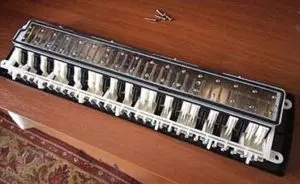
History of melodics
Melodika – a wind musical instrument of the harmonica family.  The instrument is divided into three parts: an air intake (breathing) valve, a keyboard and an internal air cavity. The musician blows air through the mouthpiece channel. Further, by pressing the keys on the keyboard, the valves open, which allows the air stream to pass through the reeds and adjust the volume and timbre of the sound. The tool has, as a rule, a range of 2 – 2.5 octaves. In the classification of musical instruments developed by the Soviet music theorist Alfred Mirek, melody is a type of harmonica with a keyboard.
The instrument is divided into three parts: an air intake (breathing) valve, a keyboard and an internal air cavity. The musician blows air through the mouthpiece channel. Further, by pressing the keys on the keyboard, the valves open, which allows the air stream to pass through the reeds and adjust the volume and timbre of the sound. The tool has, as a rule, a range of 2 – 2.5 octaves. In the classification of musical instruments developed by the Soviet music theorist Alfred Mirek, melody is a type of harmonica with a keyboard.
History of the tool
In 1892, in one of the issues of the popular Russian magazine Niva, there was an advertisement for a Zimmermann keyboard harmonica.  The advertisement said that the air in the “folk accordion flute” is supplied by the mouth through the valve, or by pressing a special foot pedal. At that time, the instrument did not gain wide popularity. When the First World War began in 1914, the firm of the German J. G. Zimmerman was recognized as “enemy property”. Several stores, including the largest branches in Moscow and St. Petersburg, were destroyed by a crowd of revolutionaries. The drawings, like the harmonicas themselves, were lost.
The advertisement said that the air in the “folk accordion flute” is supplied by the mouth through the valve, or by pressing a special foot pedal. At that time, the instrument did not gain wide popularity. When the First World War began in 1914, the firm of the German J. G. Zimmerman was recognized as “enemy property”. Several stores, including the largest branches in Moscow and St. Petersburg, were destroyed by a crowd of revolutionaries. The drawings, like the harmonicas themselves, were lost.
Half a century later, in 1958, the well-known German company Hohner produces a similar musical instrument called the melody. It is the Hohner melody that is considered the first full-fledged sample of the new instrument.
In the 1960s, melodic music gained wide popularity all over the world, especially in Asian countries. Most of the major music companies of that time took up the production of a new type of harmonica. Melodika was produced under different names, including melody, melodyon, melodihorn, clavier.
Types of melodics
- Soprano melody (alto melody) is a variant of a musical instrument with a high tone and sound. Often such melodics were made for playing with both hands: black keys of one, white keys of the other.
- Tenor melody. As the name implies, this type of melody produces a pleasant sound of low tones. The tenor melody is played with two hands, the left hand holds the crank and the right hand plays the keyboard.
- Bass melody is another type of musical instrument that has a low-pitched sound. Such instruments periodically appeared in symphony orchestras of the last century.
- Triola is a small, musical instrument for children, a diatonic variety of melodic harmonica.
- Accordina – has the same principle of operation, but differs with buttons like an accordion, instead of the usual keys.
The variety of sounds produced by this instrument allowed melodics to strengthen their positions both in solo and orchestral work. It was used by Phil Moore Jr. on the 1968 album Right On, Henry Slaughter on the famous 1966 song I’ll Remember You, and many others.





